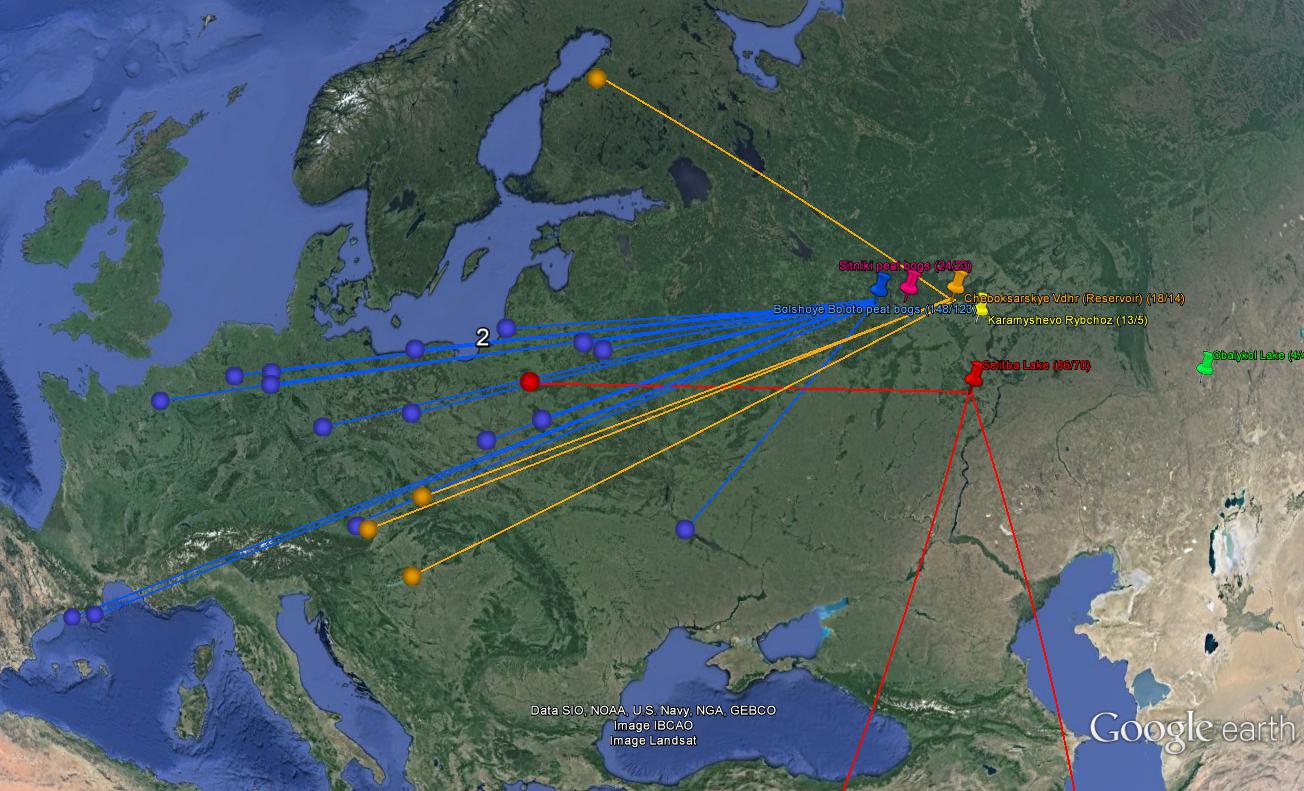 Herring Gull (argentatus & argenteus)
Herring Gull (argentatus & argenteus)
(last update: February 11, 2013)
Herring Gull (argentatus type) 96P3 2CY & 7CY, January 2009 & November 2014, Spain & Belgium. Picture: Quique Carballal & Peter Adriaens.
Green 96P3, ringed as pullus in June 2008 at Bolshoye Boloto, c. 300 km east of Moscow, Russia.
Info on location: HERE. The bird has been reported earlier from Spain, both times considered t be cachinnans:
(9) Girona. There was a 3w ringed in Russia (96P3) at Solius dump, Girona, on 22.1 (Carlos Álvarez Cros).This bird had been seen in 2009 at Vilanova i la Geltrú, by Quique Carballal.
below: Herring Gull (argentatus type) 96P3 7CY (7th cycle), November 28 2014, Oostende, Belgium. Picture: Peter Adriaens.
Herring Gull (argentatus type) 96P3 2CY (1st cycle), January 27 2009, 28 2014, Vilanova i la Geltru, NE Spain. Picture: Quique Carballal.
Strong winds, which blasted in over 100 Kittiwakes into the Iberian peninsular. Few days earlier, a gull with green ring 96P3 was reported by Carles Carboneras. It was assumed to origine from Poland, where the ringing station document birds "as Larus argentatus group". Quique Carballal and Marc Olivé found the bird again and a few pictures were taken, after which Greg Neubauer was contacted about this bird. His reply:
"This bird was not ringed in Poland, so the recovery will not be processed by the ringing centre. Apart from that I have very good news! This record perhaps is a record distance ever proved by ringing recovery from a Herring Gull and apparently the longest way traveled by a HG from European Russia. Please find ringing data below:
Ring: 96P3, green (no metal ring)
Species: Larus argentatus (Herring Gull)
Date: 07.06.2008 Place: Bolshoye Boloto, Ivanovskaya oblast, Russia, 56.30' N, 42.15' E
Age: pullus (chick)
Ringers: Esergepov AA, Chudnenko DE, Neubauer G, Zagalska-Neubauer MM, Kiselev RJ, Kiseleva SV
Distance: 3390 km (!!!)
Direction: 240,0 degrees
Still, in the colony where 96P3 was ringed, L. argentatus (Herring Gull) predominates (ca 90%), but some L. cachinnans (Caspian Gulls), some L. heuglini and L. fuscus (both forms of Lesser Black-backed Gulls) do breed as well, in mixed pairs sometimes (we recorded two such pairs between argentatus and heuglini). So, without knowing parents exactly we will never be sure about the species. And here a big ask to you: if you have any (even very bad) photos, please send them to me - I'm extremely interested how this bird looks like. If you don't have any pics, please take some if you will be so lucky to relocate the bird once again. I must add that normally HG travels much less distances - even L. cachinnans from Poland which is far better traveler, only exceptionally reaches Spain. So its really a unique recovery and pehaps one of a very few you can have in Spain about such a distant gull. Please let me know about the photos :-)
With best wishes, Greg
From thye pictures, it is just visble that several wing-coverts have been included in the post-juvenile moult (which is rare in Herring Gull).




